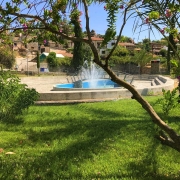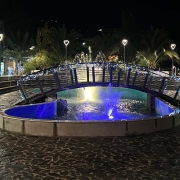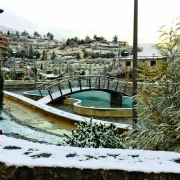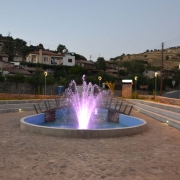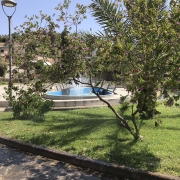History
Xyliatos is a village of the Lefkosia District. It is built 50 kilometres southwest of the capital city of Lefkosia, on a mean altitude of 515 metres.
The Xyliatos dam and the homonymic excursion site are landmarks for our village. Many visitors come to Xyliatos to enjoy the peace and beauty of the dam located in the hug of a green mountain, which is reflected on the crystal water of the dam, this way creating an image full of magic.
Historical background
The village existed since the medieval years, as it appears from the naming Filato which is marked on old maps and which is also mentioned below. Karouzis clarifies that the village is marked on Venetian maps and adds that according to Mas Latri, it used to be a royal estate during the Frankish occupation.
Population
From 1881 until 2001, as it is presented on the following table, the population of the village has met many variables. Nowadays, Xyliatos is able to maintain and even increase its population thanks to the important developmental steps that have been taken in the past years.
| Year | Population | Year | Population |
| 1881 | 42 | 1960 | 131 |
| 1891 | 69 | 1973 | 142 |
| 1901 | 71 | 1976 | 177 |
| 1911 | 66 | 1982 | 122 |
| 1921 | 158 | 2001 | 123 |
| 1931 | 131 | 2009 | 150 |
| 1946 | 110 | 2011 | 138 |
Naming
The name of the village, as Nearchos Clerides remarks, is linked to the owner of the area who was named Xylias. The medieval ending – atos was added to the name to state ownership. Clerides also adds that this owner either possessed forest land or he was a lumberjack. The Great Cyprus Encyclopaedia completes that, in the old maps, the village was marked by the name Filato, possibly an alteration of the Greek name that occurred during the Frankish and Venetian occupation.
Natural Environment
Wild and yew vegetation interchange harmonically this way creating wonderful scenery. Spread on the one side is the green thyme and the low bushes, whereas the other side is covered with vegetable cultivations and some types of citrus fruits. What is also worth mentioning is the fact that part of the village is covered by the state forest “Adelfoi”. One can enjoy the beauty of nature by strolling along the Nature Paths and the Excursion site of Xyliatos. More: Natural Environment
However, the most impressive image of Xyliatos, and possibly the reason which makes the village so well known, is the Water Dam of Xyliatos with its surrounding low green hills. More: Xyliatos Dam
Memi Mine
The Memi Mine operated in the community during the years 1954-1971 and partly during the period between 1987 and 1990.
The extraction was done on the surface using the closed excavation method and approximately 2.125.000 tons of pyrite with a mean content of 26% S were extracted.
The ore was processed at a metal enriching factory in Mitsero so that a Sulphur condensate would be produced using flotation.
Up until 1974 the final product was loaded on boats in Karavostasi and from there it was exported, while after 1974 exportation took place at the port of Vasiliko.
What is noteworthy is that towards the end of the 1980s, the final product supplied the Sulphur Acid and Fertilizer factory in Vasiliko.
Alestos Mine
The Alestos Mine first operated during the years 1971-1972, when approximately 661 000 tons of ores with a mean content of 0,9 % Cu were extracted using surface exploitation.
The ores were processed at a metal enrichment factory located in Mitsero so that a copper condensate would be produced using the method of flotation.
The final product was exported after being loaded on boats in Karavostasi.
What must be noted is that during the 1980s a small hydro-metallic unit, which produced copper precipitates, operated in the area of the mine.
The unit used a method of extraction which was based on the use of a slightly acid solvent and the submerging of solvent copper and iron (scrap iron).
(http://www.troodos-geo.org/cgibin/hweb?-A=8&-V=troodos).
Churches
In our village, there is a church dedicated to Agios Mamas and a cave also dedicated to the same Saint. According to tradition preserved by the residents of the village from generation to generation, Agios Mamas used to live in a cave in the village and that he would use the entire village as grassland. For further information, both about the Church and the Cave, click on: Churches
Sources:
Giorgos Karouzis, Strolling Around Cyprus, Lemesos, City and District, Lefkosia 2001
Xyliatos Community Council
Great Cyprus Encyclopaedia
Organized Groups
Athletic Club “Agios Mamas Xyliatou”
The Athletic Club “Agios Mamas Xyliatou” was established in 1989 aiming to keep the youth in the community by offering them a healthy occupation in sports.
The Athletic Club, during its 20 year-long course, has many important achievements to present and at the same time look into the future with optimism. In particular, the club has managed to win the championship in the Second Division of the Agricultural Championship EPOPP three times and also to win the championship of the First Division once. Moreover, the Club managed to play in the Cup final of EPOPP four times.
In addition to all this, the Club actively participates in all the events of the community and organizes the annual memorial of the community’s missing hero Xenofontas Petemerides.
The Committee of the Athletic Club is formed by:
- Kyriakos Antreou (president)
- Andreas Papaioannou (secretary)
- Andreas Ashiotis (cashier)
- Chirstos Spanos (member)
- Michalis Damalas (member)
Source:
Xyliatos Community Council
Cultural Club “Agios Mamas”
The Club was created in 2002 after initiative by a group of villagers and aims at maintaining the traditional culture of our village. The clubs course has so far been a success, mainly because it was embraced from the beginning by all the residents of the community.
The club actively participates in all the activities of the community. It is actually involved directly in organizing cultural events of the community and it also cooperates closely with the Dancing Group of the community’s youth. In particular, the club organizes:
- The events on the Sunday of Easter
- The Cultural Festival that takes place every year on the name-day of our protector Saint Agios Mamas.
The Committee of the Cultural Club is formed by:
- Kyriakos Foivou (president)
- Despo Achilleos (secretary)
- Christodoulos Papaioakeim (cashier)
- Tasos Andreou (member)
- Maria Charalambous (member)
- Andreas Ashiotis (member)
- Spyroula Xenofontos (member)
Source:
“Agios Mamas” Cultural Club
Second District Girls’ Athletic Club of Xyliatos
The Second District Girls’ Athletic Club was established in 2008 aiming to keep the youth of the community and the surrounding area and also to give them the opportunity to become involved in healthy activities such as sports.
The Club participates in the Women’s First Division Championship of the CFA, in the team of Dighenis Akritas Morphou, and it is also an active participator in all cultural activities of the community.
The Committee of the Girls’ Athletic Club is formed by:
- Demos Andreou (president)
- Ektoras Michail (vice president)
- Demetris Achilleos (steward)
- Andreas Milidonis (cashier)
- Despo Achilleos (secretary)
- Spyroulla Xenofontos (member)
- Efrosyni Christoforou (member)
Source:
Xyliatos Community Council
Minings
Memi
The Memi Mine operated in the community during the years 1954-1971 and partly during the period between 1987 and 1990. The extraction was done on the surface using the closed excavation method and approximately 2.125.000 tons of pyrite with a mean content of 26% S were extracted.
The ore was processed at a metal enriching factory in Mitsero so that a Sulphur condensate would be produced using flotation. Up until 1974 the final product was loaded on boats in Karavostasi and from there it was exported, while after 1974 exportation took place at the port of Vasiliko. What is noteworthy is that towards the end of the 1980s, the final product supplied the Sulphur Acid and Fertilizer factory in Vasiliko.
This mine is located very close to the residential area of the village. Today, there is a crater at the extraction area which, after an initiative by the Community Council, has been filled with rainwater, thus creating a wonderful lake which dominates the area.
In fact, the waters of the lake, due to the existence of pyrite alloy at its bottom and on the sides, change colour according to different seasons. In winter, the colour is dark green, which changes to a majestic turquoise in spring, while in the summer the water acquires a deep ocean blue colour, while its banks maintain the wonderful turquoise colour of the seas. Finally, in the autumn, the water changes completely, acquiring a light green colour while preparing to welcome the winter green colour of the forests.
Currently, this lake is a healthy habitat for various species of ducks.
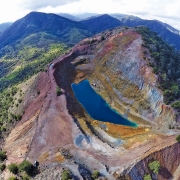
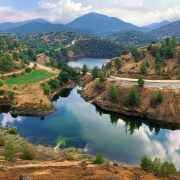
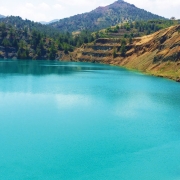
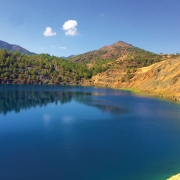
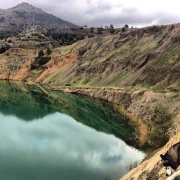
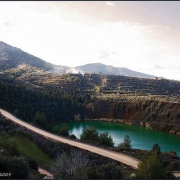
Alestos
The Alestos Mine first operated during the years 1971-1972, when approximately 661 000 tons of ores with a mean content of 0,9 % Cu were extracted using surface exploitation. The ores were processed at a metal enrichment factory located in Mitsero so that a copper condensate would be produced using the method of flotation. The final product was exported after being loaded on boats in Karavostasi.
What must be noted is that during the 1980s a small hydro-metallic unit, which produced copper precipitates, operated in the area of the mine. The unit used a method of extraction which was based on the use of a slightly acid solvent and the submerging of solvent copper and iron (scrap iron). (http://www.troodos-geo.org/cgibin/hweb?-A=8&-V=troodos).
The mine is located west of the village. The mountain in which the mine is located is found on the foothills of the Adelfoi forest, in Machairas. It stands out from a distance due to its altitude and rocks, which shine under the afternoon sun. When one visits the area where the mine used to operate, they can encounter rocks such as pyrite, while a small lake has covered the core of the mine.
The reopening of the Alestos mine is possible since there are still copper, iron and gold dust deposits in the area (Xyliatos Community Council). Based on research conducted by the Hellenic Copper Mines, the copper deposits in Alestos, Skouriotissa and Apliki are the last known deposits which are considered to be financially viable. The company is considering exploiting, apart from the Skouriotissa Mine, the deposits in Alestos and Apliki by extending its operations by 15 years (Savvas & Hatzoudes, 2014).
Nature trails
In Xyliatos there are two Nature Paths”. The first one, which is three kilometers long, “spreads” along the perimeter of the Dam, offering visitors with the opportunity to get to know the wild vegetation of Xyliatos.
The second path, which is 2000 metres long, can be accessed from two entrances. The first access is on the road which leads from Xyliatos to Lagoudera, one kilometer away from the village, whereas the second one in from the old bridge located within the village. The second entrance leads to middle of the route. The dominating element detected during strolling is the geological formation of “Stitipetra” or else “Stitorotsa”, in the east of the village, and which is described below, as well as a cave which leads, according to tradition, to Lagoudera. Additionally, the path crosses the sparse pine forest which develops on abandoned cultivable land, as well as cultivations and orchards. Apart from all the aforementioned, ramblers have the opportunity to enjoy, along the path, spots with wonderful open view, both towards the surrounding mountains and the valley in the west (towards the forestry scenery – the pine forest), the mines and the relevant activities in the area, our picturesque village, as well as the slopes covered with bushes and brushwood.
Sources:
Giorgos Karouzis, Strolling Around Cyprus, Lemesos, City and District, Lefkosia 2001
Xyliatos Community Council
Town Planning Law (Laws 90 of 1972 and the Amending Relevant Laws)
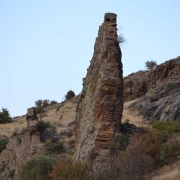
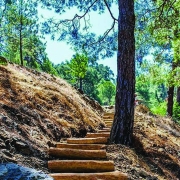
Dam
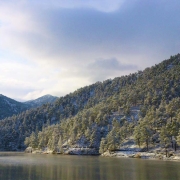
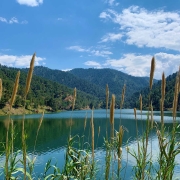
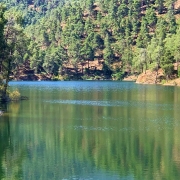
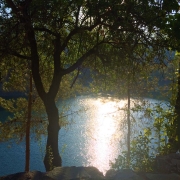
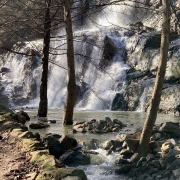
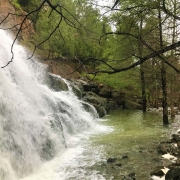
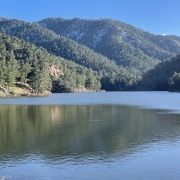
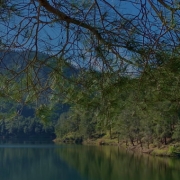
Picnic area
The picnic area near the water dam of Xyliatos is located Southwest of Nicosia, at a distance of approximately 50 km through Nicosia and Morfou (exit the highway on the left and drive past the villages of Peristerona, Xyliatos and Lagoudera), or at a distance of approximately 45 km via Nicosia, Palaechori (exit the highway on the right and drive past the villages of Arediou, Kato Moni, Xyliatos and Lagoudera).
The area in question, the creation of which began in 1985, is located on the foothills of the Xyliatos water dam, on an altitude of about 600 m, and covers a land expanse of approximately 7000 square metres, which has been included in the NATURA 2000 network since 2004.
The picnic area can accommodate 860 people and provides all necessary amenities for the comfortable stay of its guests. It includes 98 tables, 33 of which are covered, as well as three tables for the disabled. The site also includes three covered and seven exposed barbecue areas, five water supply points, a playground with a wall bar, four swings and two seesaws, sanitation areas based on European standards, two men’s and two women’s lavatories, two toilets for the disabled, a car park and a water extinguishing system with 13 points.
The months of July and August, as well as springtime during which visitors can combine their excursion with a walk along the nearby nature study trail, are considered to be peak visiting periods. The Trail commences at the picnic area and terminates at the same point after covering a distance of 4.5 km along the perimeter of the water dam.
The picnic area also attracts visitors during February and March in case the dam overflows. In the year 2012, due to the increased rainfall, the dam overflowed for five months, from January until Mary. In fact, the beautiful spectacle offered by the dam’s overflow, which continued for several months, urged the Community Council of Xyliatos to start making efforts for the construction of an artificial waterfall which would operate during the months when there would not be an overflow so that every visitor could enjoy this majestic sight at any time of the year.
It can host up to 700 people.
Source: Xyliatos Community Council
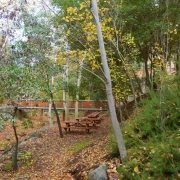
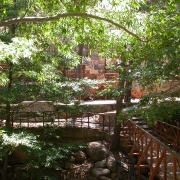
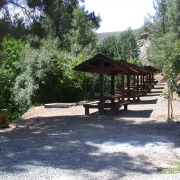
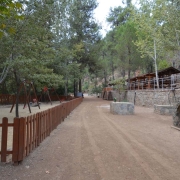
Projects
Revival of rural, mountainous and arid areas through the creation of authentic experiences to enrich and upgrade the tourism product.
New project budget €85,108.65
Stadium
At the entrance of the village is the Community Field. It has grass and floodlights to light up at night, and that’s where the young people of the village gather – mainly in the summer – to play football.
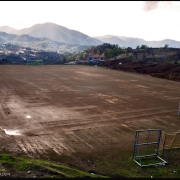
Artificial Lagoon
The Artificial Lagoon was created in 2012 and its construction was undertaken by the Community Council of Xyliatos. The lagoon constitutes the first phase of the community’s reformation plan, which aims at modernizing and developing the village so as to urge the youth to remain in Xyliatos.
The lagoon is located at the square of the village and it is adjacent to the main road of the community leading from Xyliatos to Lagoudera, thus attracting several visitors as it combines both traditional and modern features.
In the lagoon there is a big water jet and two smaller ones which are illuminated using colour changing headlamps. In the middle of the Artificial Lagoon stands a wooden bridge, which separates the big water jet from the two smaller ones. Along the perimeter of the lagoon there are stands and hidden lighting, while there is also a paved road, a cycling path and a greenery area. The entire area is illuminated by a modern lighting system.
The Community Council of Xyliatos has, since 2002, envisaged the reformation of the community. The completion of the Artificial Lagoon is only part of the Council’s plans and in the future the area will be used as the venue for various events.
Sources:
Xyliatos Community Council
